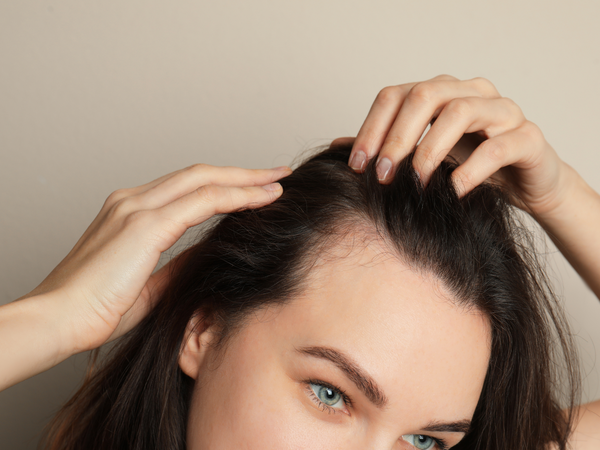Cassia: Everything You've Ever Needed to Know About Colourless Henna

CASSIA: Everything You've Ever Needed to Know About Colourless Henna
One of the most beautiful uses of Ayurvedic herbs is the use of Cassia, or colourless Henna , for colour, shine and a gold tint.
Whilst it isn’t a ‘hair colour’ as such, Cassia Auriculata has many benefits for all hair types and as such, is one of our most popular hair care products.
In this article, our hair experts share the ways to get the best out of your hair with Cassia, recipes you can use to tell if your Cassia is the right type.
What is Cassia Auriculata
Cassia Auriculata an ancient herb, with tiny yellow flowers native to the Asian and African subcontinents. Cassia is from the same family as Henna, but they have different properties.
Once the plant reaches maturity and flowers, it is dried and powdered, turning into a lighter green powder then Henna. You can tell the quality as good Cassia feels more like talc and is very fine.
Historically, it was chosen to treat wounds and impact healing, which we discovered with research is spot on. The compounds in Cassia are naturally anti-fungal and antiseptic.
Over the years, people realised that not only did these benefits improve itchy sore scalps, but their hair looked better – often brighter, shinier, and more manageable.
Starting from the basics, Cassia does not stain your hair like henna. It also does not reduce shrinkage or significantly colour grey.
Cassia is not Colourless, nor is it Henna
Cassia is commonly known as neutral Henna or colourless Henna, but it isn’t Henna at all.
The leaves contain yellow resin pigment, which is why it can add beautiful gold lights, but on most hair colours it just adds a glimmering shimmer, rather than outright colour.
The Benefits of Cassia for Hair
The same benefits of Henna without the colour commitment:
There’s no staining with Cassia, except on the lightest hair shades, so it’s perfect for taking advantage of henna benefits without the bright red tint.
It doesn’t loosen your hairs curl pattern
Henna is renowned for losing the curl patterns of afro and 4c hair, but Cassia does not, which is great if you’re trying the curly girl method or trying to get your curls in tip top shape.
It’s antiseptic so ideal for scalp allergies and dandruff
Dandruff is often caused by an overgrowth of yeast on the scalp, fed by the natural oils in the scalp. Cassia helps reduce this overgrowth so as to reduce flaking and dryness without some of the ‘stripping’ effects of mainstream dandruff shampoos.
It’s anti-inflammatory to help your scalp heal from itching and soreness
Many mainstream hair dyes and conditioners contain ingredients like PPD and SleS, which are detergents and preservatives that are deeply irritating to the scalp.
As a result, in recent years, there’s been a surge of people seeking support for sore, damaged scalps. Often, this doesn’t require medical treatment, just a more natural approach.
Cassia is preservative free and the anti-inflammatories are so soothing for sore scalps as they heal.
It’s not permanent
Unlike Henna, the effects of Cassia are not permanent, lasting on average up to three weeks. Whilst this means a little more maintenance, you’re not stuck growing out super intense colours if you change your mind.
It’s perfect to enhance greys
If you’re going grey and you want some natural golden lights, use Cassia. Whilst Cassia cannot lighten the hair, the yellow pigments deposit little hits of sunlight to lighter hair that deepens to gold as you build it up.
Natural, silicone free conditioner
As opposed to a colour like Henna, Cassia is a natural conditioner. Even if your hair is very dry, highly processed or even recently permed, Cassia offers a lovely way to soften coarseness, smooth frizz and reduce breaking.
Because it doesn’t have ingredients like silicon, it also washes out of the hair completely, reducing product build up which stops volume and glossiness over time.
Add shine
For those with darker hair, or curly hair which doesn’t reflect light as well, it can be challenging to get a good ‘shine’ on your hair. Cassia works with the hair's natural structure to smooth follicles without damage, making them more light reflective and better able to shine.
Restore lost volume to your hair
We often recommend Cassia, alongside Ayurvedic Bhringaraj to women who have experienced hair fall caused by hormones for example during menopause or post partum.
Cassia helps to boost the volume of the scalp naturally, while Bhringaraj reduces hair fall so the two together are a superhero duo for fine haired types.
To Get the Best out of Your Cassia:
Choose the type of Cassia you want to use
You can buy pre-mixed Cassia, but it’s often ‘cut’ with other ingredients. We supply pure Cassia powder, which is more trustworthy, but it does require mixing (takes about 60 seconds).
After you're done, rinse out the Cassia Auriculata with a sulphate-free shampoo and/or conditioner. You can use sulphate-containing hair products after you first rinse it out, but if you haven't washed it out it might strip the Cassia Auriculata from your hair.
If your hair is very light, strand test. This way you’ll be certain of the time you need to apply it and the colour result you are likely to enjoy
Consider mixing with Henna. It will add a golden ‘peachy’ tone to your colour.
Patch Test. Whilst Cassia is rarely allergenic, it can happen so always do a patch test to ensure you aren’t going to react to it. Apply a small amount mixed with your chosen liquid to either the wrist or a patch behind the ears. If there is any redness or irritation, do not use it.
Know your water type If you have "hard water" (water with an enormous amount of minerals), your hair may turn green due to mineral buildup – remember to strand test and consider a deep clean using a pre-wash first.
Many confuse Cassia Auriculata with Cinnamomum Cassia (Cinnamon). Although they are in the same family of plants, they are not the same and you cannot substitute Cinnamomum or vice versa. It will not taste nice in cooking and Cinnamon will not colour hair.
Getting More out of Cassia
Cassia on its own is powerful but when mixed with other ingredients, you can release a heap of fun and creativity, plus additional benefits.
Some ideas to try:
o Chamomile tea, for radiant gold tones, especially on light hair
o Lemon juice for extra ‘sunshine’ and brightness
o Amla, which is good for adding shine and volume
o Henna, which creates warm, peachy and glowing tones
o Cinnamon can add warm red or auburn tones.
o Powdered cloves help reduce the cassia scent (not unpleasant, but grass-like)
o Honey and yoghurt, which creates a soothing mask for dry hair and sore scalps
How Much Cassia Do I Need?
- 100g for short hair
- 200g for shoulder length hair
- 300g for long hair
- 400g for waist length hair
How do I Make Up My Cassia Mix?
- Add the Cassia Auriculata powder to a non-metallic bowl
- Use warm water, or your chosen liquid to blend to a thin liquid consistency
- Apply the mixture from roots to ends
- Leave the paste on your hair for half an hour minimum, up to two hours
- Rinse and shampoo if necessary
For blonding, leave for up to three hours.



